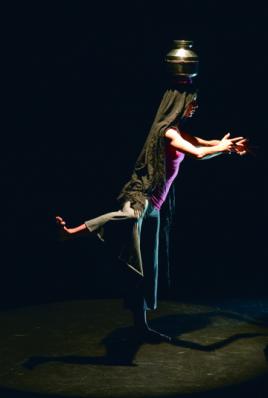Edge 3, Women on the Edge

The tone for Industry of Dreams, the first of two performances in Edge Three, was set with an opening, deliberately amateur film of India’s daily life mixed in with dancing. Traditional theatrical dancing mixed with dervishes fade into scenes of people riding buses. The mood is set: This is India, and India is movement.
Then three dancers make their entrance. The first one – Namchi Bazar, the choreographer of the Industry – wears a dark sari and carries a metal jug atop her head. Two others (Angie Cheng and Sara Wiskar), dressed in red saris, seem to be stoic, veiled statues in the background.
When Bazar starts a slow traditional dance, I realize I don’t know what specific style it was, or what the symbolism of the movements were. However, Bazar probably predicts that only some of her viewers will know the language of Indian dance, and some will not. All I can tell you is that it was the kind of dance that inspires you to learn more.
The dance follows a simple storyline. Bazar gathers water from the riverside, falls in love with the simplicity and sweetness you would expect from a girl in love for the first time, and dances with flair in the explosive Bollywood dance scene ending. Her two cohorts have a humourous scene where they are practicing Bollywood dance moves together.
There are, however, a couple of elements which detracted from the piece. The video projection ranged from awful to terrible. It felt like I was watching a 90’s karaoke video. The few redeeming bits of footage from India included a screensaver cartoon motorcycle helmet floating across the screen.
And this brings me to the second disappointment in the piece: the motorcycle-mama scene. I understand that with something called “Industry of Dreams” you have a lot of leeway in what you can include in the flow, but this scene had all the smoothness of an impromptu root-canal being given during a picnic. Maybe they were trying to put forth the “wild and free” part of a woman’s psyche, but the choreography here very much missed the target.
If you exclude those two elements, Industry of Dreams has a lot of potential. It is a relevant display of the universality of women in a culture moving out of a caste-system.
Sleeping Booty was a wonderful surprise. I went in hoping for the best, but secretly I was expecting to see another “statement on women in fairy tales” – a perfectly valid topic, but one that is brought up by every enlightened woman at some point shortly after childhood.
What was actually produced was a feast for the eyes largely influenced by a book called FETISH Fashion, Sex and Power by Valerie Steele. The scene where the three women realize that they are all married to Prince Charming is particularly humourous, and rife with double-entendres.
When the strongly plot-driven performance opens, three fairy-tale ballerinas are at a crossroads between being little girls, Stepford wives, and submissives. The story opens with Snow White reading an excerpt of Grimms’ German version of Cinderella. The one step-sister is trying on the shoe, but as much as she wants it to fit, it’s not going to work.
She leaves the room and returns it to the prince, “with blood in the shoe.” Cinderella commences her ballet, toying with and eventually putting on the shoe. Her dance, and Snow White’s later when it comes, is doll-like. At last Sleeping Beauty, who has been unconscious on a bed of rose-petals all of this time, is woken by the two other princesses. They control her as if she was a marionette; because her legs are powerless, she falls when she pirouettes.
The dances feel like they were stylized by Salvador Dali, especially at the end when the women walk like animals, their limbs extended to the maximum, their hands in shiny stripper shoes.
The show was well worth seeing, either on its own (some future time), and also in the specific context it had within Edge Three. Juxtaposed with Bazaar’s Industry of Dreams, which is about the reality of women rather than how they have been misperceived, Sleeping Booty's fairy-tale elements seem even more surreal than they would if the performance was seen on its own.
* * * * * * * * *
Edge Three is a presentation of the Dancing on the Edge 20th Anniversary Festival, July 8 & 10, 2008
Industry of Dreams (Namchi Bazar, Vancouver)
Choreographer: Namchi Bazar
Performers: Namchi Bazar, Angie Cheng, Sara Wiskar
Music composition: Sage Reynolds
Video & Motion Graphics: Melissa Weigel
Sleeping Booty (Joe Ink, Vancouver)
Artistic Director/Choreography: Joe Laughlin
Performers: Lina Fitzner, Marissa Gomez, Simone Kingman
Costumes: Maura De Marco
Lighting: James Proudfoot
Music: George Bruns, Sergey Prokofiev, Peter Tchaikovsky



